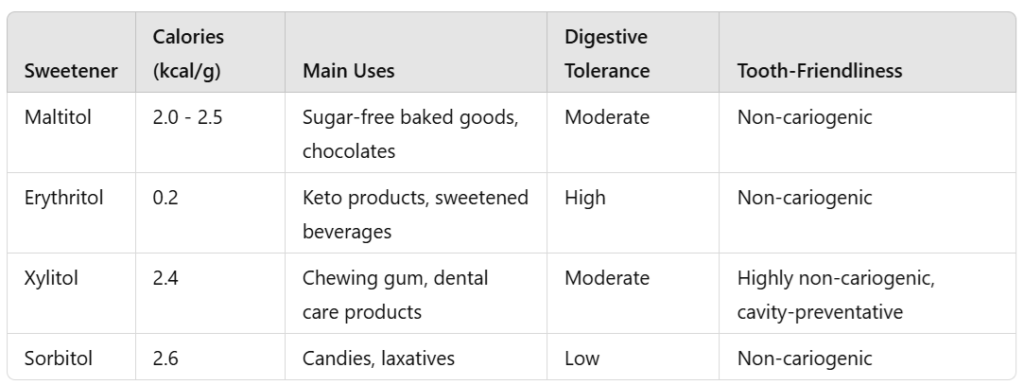Maltitol, a widely used sugar alcohol, is a low-calorie sweetener found in sugar-free and reduced-sugar products.
Derived from maltose, it offers sugar-like sweetness with fewer calories and a lower glycemic effect.
However, it also presents some concerns, particularly regarding digestive side effects.
This blog explores the science behind maltitol, focusing on its safety, metabolism, and potential side effects.
Metabolism and Caloric Content of Maltitol
Maltitol is a disaccharide alcohol, produced by hydrogenating maltose.
It provides around 2-2.5 kcal/g, which is about half the caloric content of regular sugar (sucrose), which offers 4 kcal/g.
This reduction in calories is due to it’s incomplete absorption in the small intestine.
- Absorption: Approximately 40-50% of maltitol is absorbed in the small intestine, where it is partially metabolized into glucose, contributing to its glycemic response. The remaining portion is fermented by bacteria in the colon, leading to its characteristic side effects.
- Glycemic Index: It has a GI of ~35, significantly lower than sucrose (which has a GI of 65), but still contributing to a mild increase in blood glucose levels. This makes it suitable for people looking to reduce sugar intake, though not for strict ketogenic diets or those managing diabetes.

Potential Side Effects: Gastrointestinal Impact
One of the most significant safety concerns associated with maltitol is its impact on the digestive system.
Due to incomplete absorption in the small intestine, unabsorbed maltitol travels to the large intestine, where it is fermented by gut bacteria.
- Gastrointestinal Discomfort: This fermentation process produces gas, leading to symptoms like bloating, flatulence, and abdominal discomfort. At higher doses (above 20-30 grams per day), it can have a laxative effect, resulting in diarrhea. These effects vary based on individual tolerance, but they are more pronounced compared to other sugar alcohols, like erythritol.
- Tolerance Level: Studies have shown that consuming 10-20 grams of maltitol daily may cause mild discomfort in sensitive individuals, while doses above 30 grams are more likely to result in pronounced digestive issues, particularly for children or those with pre-existing gastrointestinal sensitivities.

Safety in Long-Term Use
While short-term consumption is generally regarded as safe by regulatory bodies like the FDA and EFSA, there is limited data on the long-term effects of regular, high-dose intake.
Most safety assessments focus on its acute effects, particularly digestive issues, but there is little evidence to suggest maltitol poses any long-term health risks when consumed in moderation.
- Daily Intake Limits: The European Food Safety Authority (EFSA) has determined that there is no need to establish an upper limit for maltitol consumption, as the side effects are dose-dependent and temporary. However, the Food and Drug Administration (FDA) requires that products containing maltitol carry a warning for potential laxative effects if consumed in excess.
- Dental Health: Like other sugar alcohols, maltitol is non-cariogenic, meaning it does not contribute to tooth decay. In fact, it can be used in products designed to promote oral health, such as sugar-free chewing gums, though it is less effective than alternatives like erythritol in inhibiting cavity-causing bacteria.

Comparing Maltitol to Other Sugar Alcohols
When comparing maltitol to other sugar alcohols such as erythritol and xylitol, several key differences in safety and side effects emerge:
- Digestive Tolerance: Erythritol, which is almost fully absorbed and excreted unchanged in urine, has a much higher tolerance level, with fewer gastrointestinal side effects. Maltitol, in contrast, is more likely to cause digestive discomfort due to partial absorption and fermentation in the colon.
- Caloric Content: It has about 2-2.5 kcal/g, higher than erythritol (~0.2 kcal/g) but lower than xylitol (~2.4 kcal/g). This makes it a middle-ground choice for those looking to reduce calorie intake but not eliminate it entirely.
- Glycemic Impact: Erythritol has a GI of 0, while maltitol’s GI of ~35 means it still has some effect on blood glucose levels, making it less ideal for people with diabetes or those following strict low-carb diets.

Conclusion
Maltitol provides sugar-like sweetness with fewer calories and a moderate glycemic impact, making it popular in sugar-free products.
However, its digestive side effects and glycemic response may be problematic for those with sensitive systems or strict dietary needs.
Understanding its benefits and side effects helps in making informed choices.








